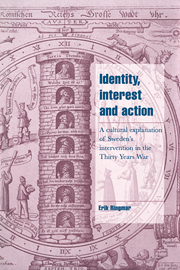 Identity, Interest and Action
Identity, Interest and Action Book contents
- Frontmatter
- Contents
- List of illustrations
- Acknowledgements
- Introduction: the beginning of the story
- Part I A narrative theory of action
- Part II Why did Sweden go to war in 1630?
- 4 Historical and cultural preliminaries
- 5 Fighting for a national interest
- 6 Fighting for a national identity
- Conclusion: the end of the story?
- Notes
- Bibliography
- Index
4 - Historical and cultural preliminaries
Published online by Cambridge University Press: 21 October 2009
- Frontmatter
- Contents
- List of illustrations
- Acknowledgements
- Introduction: the beginning of the story
- Part I A narrative theory of action
- Part II Why did Sweden go to war in 1630?
- 4 Historical and cultural preliminaries
- 5 Fighting for a national interest
- 6 Fighting for a national identity
- Conclusion: the end of the story?
- Notes
- Bibliography
- Index
Summary
Time now to return to our case study and explain why Sweden went to war in 1630. Our explanation will proceed in two steps. We will begin by investigating to what extent the decision to go to war may have been prompted by Sweden acting in defence of its national interest. We will look for the interests – religious, military, economic or other – which may have caused the country to intervene. Secondly we will ask to what extent the decision may have been prompted by Sweden acting in defence of its national identity. We will study how a Swedish identity was formed during the course of the sixteenth and the early seventeenth centuries and investigate in what sense – and based on what evidence – the decision to go to war can be said to have been a result of this process of identity formation. As I shall try to make clear, it is only once this second step in our investigation is taken that we can conclusively explain the Swedish action.
Before we can turn to a direct study of the source material, however, we need some basic knowledge regarding the historical setting in which the intervention took place. We need to know more about the origin of the Swedish state and its development during the sixteenth century – in particular we need to grasp the dynamics of the dynastic struggles which took place within the royal family, the house of Vasa.
- Type
- Chapter
- Information
- Identity, Interest and ActionA Cultural Explanation of Sweden's Intervention in the Thirty Years War, pp. 95 - 109Publisher: Cambridge University PressPrint publication year: 1996
